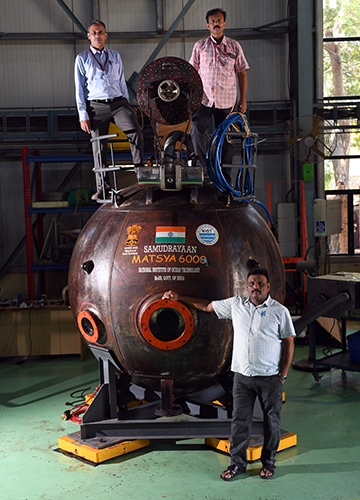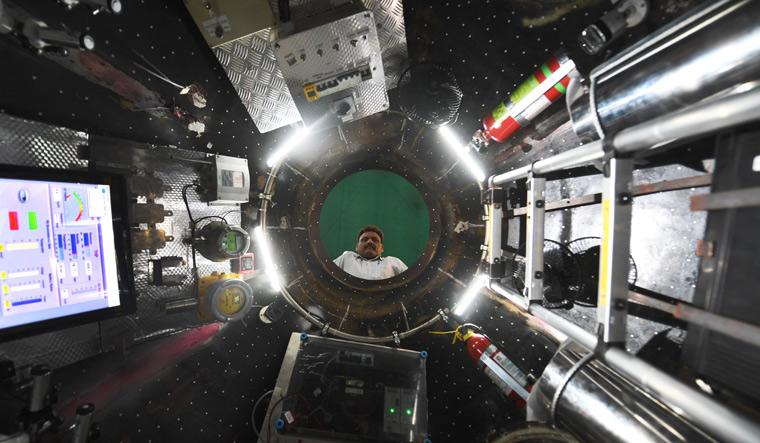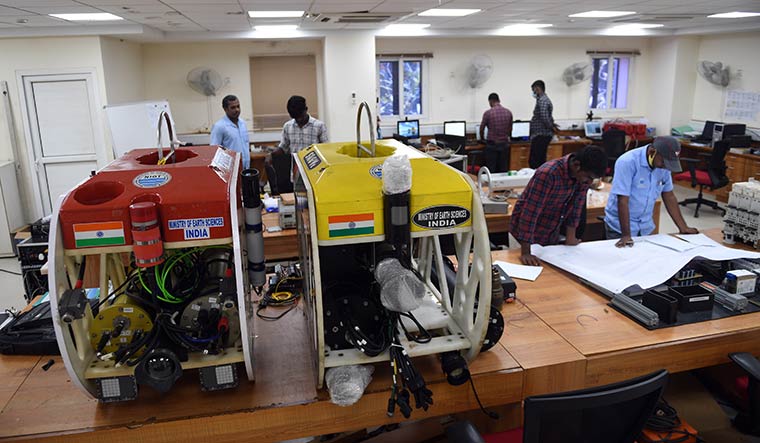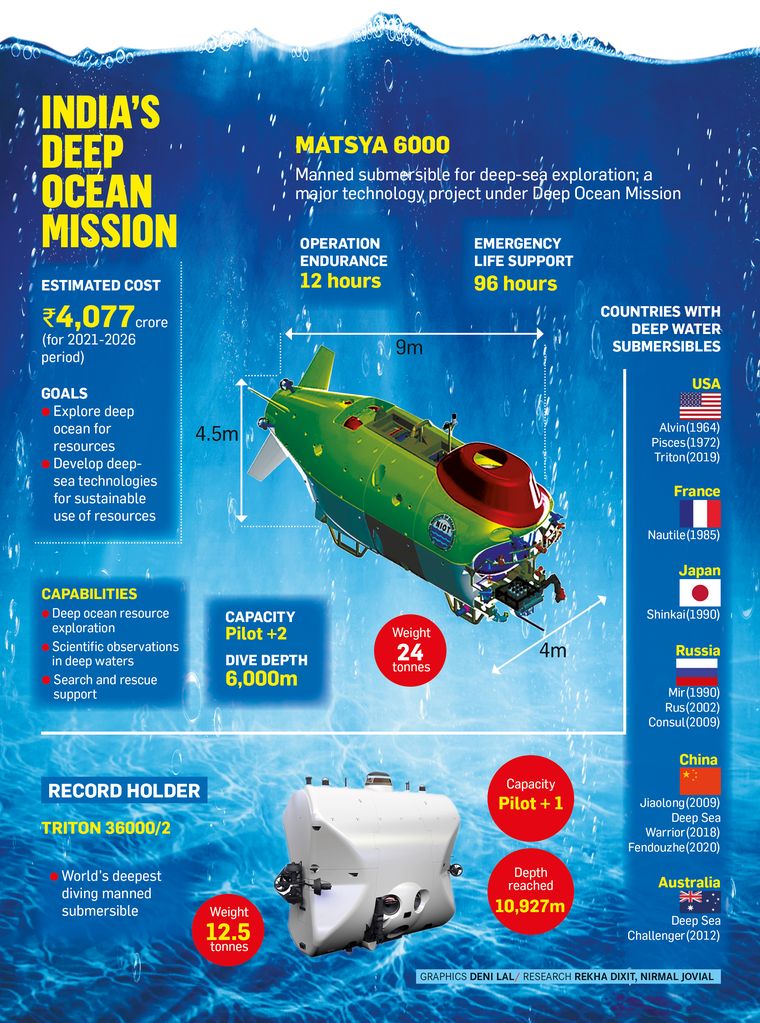Welcome On Board Mission Samudrayaan, India's Daring Deep-Sea Manned Voyage

Samudrayaan is the flagship project of India's Deep Ocean Mission
It is a steel sphere, around 14 feet high, mounted on a pedestal. I clamber a vertical ladder to reach the hatch on top, then descend another ladder to enter an alternate world. The “room” comprises a small seat for a pilot; around the inner walls runs another seat, which can take in another two passengers on either side of the pilot. My hosts squeeze in to make place for me, retracting the ladder and slotting it against the back wall, as I look around. There is a panel in front and a host of knobs and switches. Three small portholes are the windows to the outside. There are rows of oxygen canisters along the walls and two carbon dioxide scrubbers. Once the hatch is closed, we will be sealed off completely; the oxygen canisters will release life-giving air slowly, while the scrubbers will filter the air in the cabin, removing carbon dioxide from it. It looks like a space capsule, except that there is gravity here.
The Art and the artists: (Clockwise from left ) NIOT scientists R. Ramesh, S. Ramesh and N. Vedachalam with the prototype of the human quarters of Matsya 6000

We are at the National Institute of Ocean Technology. Formed in a room at the Indian Institute of Technology Madras with five members in 1993, this institute now occupies a 50-acre campus at Velachery. It is the country’s premier institute in developing ocean technology—desalination plants to provide fresh water for islands, recreating beaches lost to anthropological activities, tsunami warning and weather prediction systems, and even ocean fish farming. Unlike the Indian Space Research Organisation, which has become a leviathan organisation with several centres, NIOT is small—10 scientists in the core team for developing Matsya 6000, eight working on the miner, Varaha-1. “Every scientist, however, has spent more than a decade on the high seas. That is why I call them young veterans,” says GA Ramadass, director, NIOT. “In a decade, NIOT will be a world leader in developing ocean technology, if not ahead of others, at least on par. ”We have done an extensive survey of the Indian Ocean with scientific instruments, but nothing can beat the human eye. —G.A. Ramadass, director, National Institute of Ocean Technology Matsya-6000 is not likely to touch the sea bed, but hover some metres above it. It will be capable of turning around 180 degrees, giving the crew a greater viewing scope.Matsya 6000 is designed to provide 96 hours of oxygen supply, in case of an emergency. If anything goes wrong, the vehicle will begin moving upwards, and the return leg can be sped up by a couple of hours.
India launched the Deep Ocean Mission in 2021, which hinges on developing new technologies that NIOT is spearheading. The flagship project is Samudrayaan.
India is not the first to send humans to the bottom of the ocean. The US, Russia, France, China, Japan and Australia have extensive underwater missions. The Americans had a head start, with their crewed submersible DSV Alvin making its first voyage in 1965 to a depth of 1,800m.
Of late, deep ocean voyaging has even become touristy, with those who have the money getting into private cars to view the deep, just as they are hopping onto spaceships for a spin around the earth. Filmmaker James Cameron took a submersible ride into the deepest part of the Mariana Trench (10,908m below sea level) way back in 2012. More recently, in 2019, businessman Victor Vescovo went even deeper, to 10,927m, and also became the first man to reach the top (Mount Everest) and bottom of the earth.
So, what then is different in the case of Samudrayaan? To start with, it will be a technology demonstration that will make India the seventh deep ocean exploring nation. More importantly, it will signal the start of our era of exploration with human eyes into the Indian Ocean, waters that remain largely unexplored. “We have done an extensive survey of the Indian Ocean with scientific instruments, but nothing can beat the human eye,” says Ramadass. Unlike space rockets, which are mostly single-use (though reusable technology is being developed) submersibles can be used for several voyages.

Safe Quarters: The interior of human shell of Matsya 6000
The oceans are the future for nations in several ways. With resources on land becoming stressed, the search is on for other sources. For India’s blue water economy—with a focus on tapping the riches in the sea—the Deep Ocean Mission is important, as it is necessary to understand what lies beneath. The vehicle for that crewed exploration is aptly named after the first incarnation of Vishnu, Matsya. The number 6,000 refers to the depth for which it is designed.
NIOT scientists recently conducted an important experiment. Three of them got into the sphere and spent two hours at the bottom of a 7m deep pool on the campus. The crew comprised Ramadass, S. Ramesh—the project director for the human submersible—and R. Ramesh, the electrical and communication whiz, who “piloted” the voyage. He is a veteran of an Antarctic exploration, and operated India’s unmanned, remotely operated vehicle at depths of around 200m to 500m under the frozen sea, as part of biodiversity research experiments.
Every stage of development of Matsya-6000 is certified by an external accreditation agency, explains the project director. NIOT has a tie-up with DNV, a Norway-based agency, for certification. The scientists calibrated the shell on a range of parameters and also assessed human responses inside the shell—oxygen requirement, blood pressure and other vital parameters. None of them recorded any physiological aberrations like elevated heart rate or breathlessness in the confines of the shell. The joke at the institute is that the doctor, who was monitoring their health from the outside, had his blood pressure shooting up, what with the director of the institute himself inside the shell.
“I used to be claustrophobic in my youth, but a career in ocean research took care of that problem,” says Ramadass. Spending days in cramped survey ships is one matter, getting sealed into an airtight shell is another level. He, however, had no trouble inside the shell.
The shell will also be tested soon for a crewed dip for six hours, and then, 12 hours. Later in the year, scientists plan to take it to the Bay of Bengal, off Chennai, for another test run at around 500m depth. None of these tests, however, will be anything close to the real voyage. For one, the shell will be part of a vehicle and not an independent unit. During experiments, the shell is connected to the surface with a cable. But Matsya 6000 will be an autonomous vehicle, with no moorings to the mother ship.

Brains at work: Technicians and scientists at remotely operated underwater vehicle division of NIOT
A steel shell is fine for withstanding pressure up to 500m; at greater depths, it will crumple like a sheet of aluminium foil. So, the material has to be sturdy enough to bear the pressure of a water column of 6km, and yet, be light enough to handle. Titanium is the metal of choice. The Indian Space Research Organisation is designing such a shell for the mission; NIOT is also looking at a foreign vendor for the same. The global upheavals, however, are impacting supply chains, so a ‘Made in India’ shell has immense appeal. Meanwhile, NIOT is getting the rest of the vehicle designed. The aim is that by the time the titanium shell is ready, the vehicle, too, would be.
So, what will the real journey be like? Matsya-6000 will be taken on one of NIOT’s survey ships to a spot in the Central Indian Ocean, at around 13 degrees latitude, and lowered into the water. The ship ride to this location would take around eight days. The battery-run submersible’s descent will take four hours one way, maintaining a speed of around 25m per minute. The first 100 feet, says Ramadass, will feel like being inside a washing machine, but as the submersible goes deeper, surface turbulence would cease. Initially, the crew will see a variety of life—fish, seaweeds—from their portholes. Since sunlight sustains life through photosynthesis, almost 90 per cent of marine life is in the photic zone. Gradually, the light will fade. Then, they will enter the realm of eternal darkness, the bathypelagic zone (1,000m to 4,000m below the surface), with only the headlights of the vehicle illuminating the area around them. They are likely to be staring at nothing much, just water, with some stuff floating down from the living zone. The life forms will become stranger and less abundant.
Four hours later, when they near the bottom, the cameras outside will show them new terrain, littered with polymetallic nodules—the big prize for which the world is diving deep these days. Life finds a way to exist in just every niche on earth, and many life forms have made even the dark, inhospitable sea bed their home. Some of them emit their own light. They usually have long life spans, too. Given that pollution has also penetrated every niche, India’s aquanauts are likely to see evidence of that, too.
“If you want to stare into space, all you need is a terrace and a good telescope,” says S. Ramesh. “That is why people are fascinated by it, they can see it. But they cannot see the bottom of the sea, so they have very little knowledge about this area.”

The challenge to get to the ocean bottom is perhaps even greater than finding the escape velocity to shoot out of the earth’s atmosphere. If the absence of gravity is a factor in space, its pull is a factor in the deep. Add to that, the pressure of water—which increases by one bar for every 10m down.
Matsya 6000 is not likely to touch the sea bed, but hover some metres above it. It will be capable of turning around 180 degrees, giving the crew a greater viewing scope. Within the ship, the aquanauts will not have much space to move around. The cabin will be pressurised and temperature-controlled, so, despite the weight of the ocean on it, the voyagers will be rather comfortable. They do not even need special suits, a comfortable T-shirt and jeans, with a jacket thrown in are good enough. They could have a drink or snack on some energy food, but they have to remember that there is no toilet facility here. Those luxuries will be available only at the end of the journey, once they reach the mother ship. Typically, a cruise is designed to last for around 12 to 16 hours, including travel time. The journey begins at daybreak and the aim is to get the submersible back before sunset. So, keeping another four hours for the return leg, the aquanauts will have around four hours to explore the deep. During the voyage, the travellers can peer out of the portholes, or watch the images on the panels along the walls, which the seven external cameras on the vehicle will be taking.
Who will India’s first aquanauts be? At NIOT, the scientists are eager enough to be part of the crew. After all, it is a technology they are designing, developing and demonstrating. Once, when the director asked casually about who would like to volunteer [for the test runs], he was surprised to see that almost everyone had raised a hand. They have carefully called the vehicle a human submersible, as against the commonly used name, man submersible, well aware that many women are as keen to go for such voyages. A week’s training is enough to make an aquanaut ready for the voyage. The pilot needs to know the vehicle, of course, and NIOT is in talks with the Indian Navy, hoping to get someone from the submarine branch for this job. The other passengers need to clear a basic fitness test. This journey, however, is not for the faint-hearted.
Matsya 6000 is being made primarily for exploring the Indian Ocean for hydrothermal vents, and the source of minerals around them. “The maiden voyage, however, will not be in search of the vents, but an initial cruise of the depths,” says M. Ravichandran, secretary, ministry of earth sciences.
Communication with the outside world is minimal during such a voyage. “SONAR works, but the bandwidth is limited,” says Ramadass. He, however, sees no reason for anyone to panic. The vehicle is designed to provide 96 hours of oxygen supply, in case of an emergency. It will also be designed in such a way that if anything goes wrong, the vehicle will begin moving upwards, and the return leg can be sped up by a couple of hours. “This is safer than air travel,” he says.
Samudrayaan has the target year of 2024, the same as that of Gaganyaan, India’s human space flight mission. “It will be a landmark year,” says Jitendra Singh, Union Minister for Earth Sciences. NASA astronauts from the International Space Station connect with aquanauts in underwater sea labs. Will our gaganauts and aquanauts be able to communicate with each other, too, during their voyages? There are too many odds at play here.
The two missions might not happen simultaneously. Even if they do, the window for communication is small. Gaganyaan is planned for a week’s voyage, of which the initial days will go in settling down and the last in packing up for home, leaving maybe three days. Samudrayaan has a voyage time of only around 12 hours. “It is not impossible,” says Ramadass. “We are like the proverbial bumblebee. Aerodynamically, it is not supposed to fly. But it flies because it does not know it is not supposed to fly.”



No comments:
Post a Comment